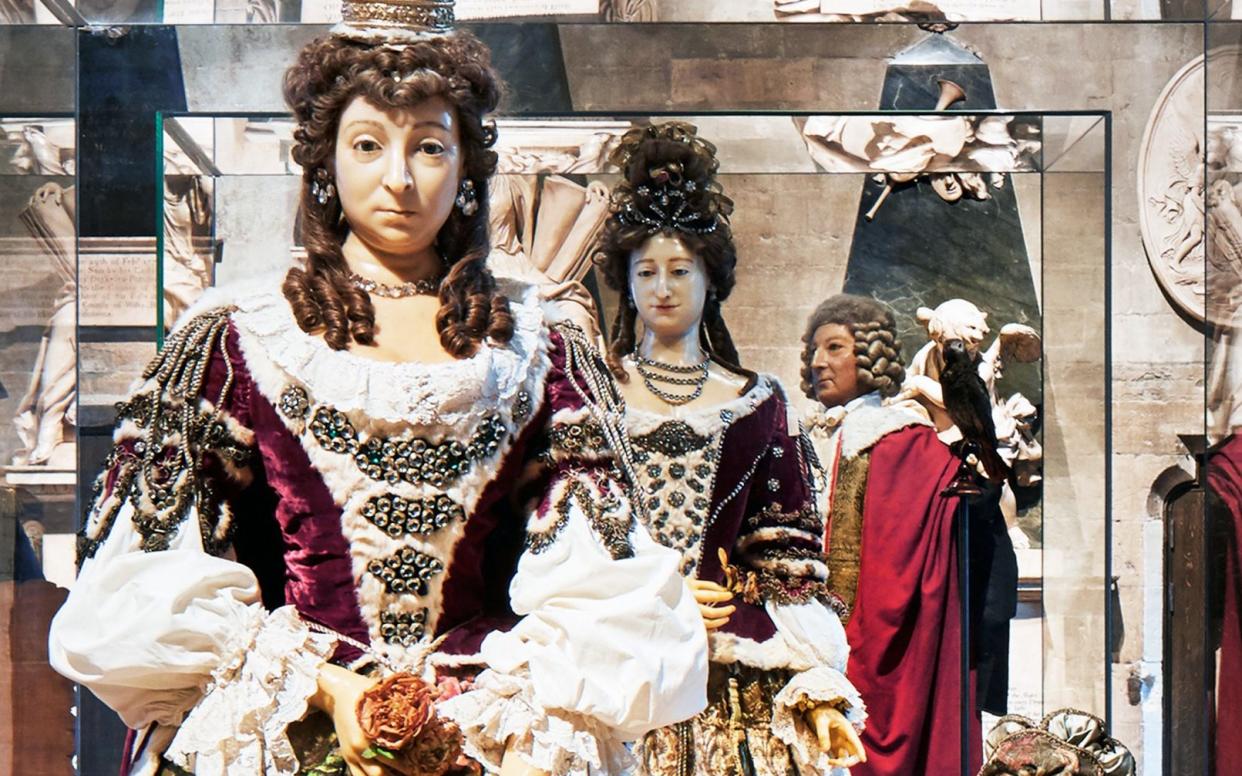Sacred Mysteries: The surprising waxworks of Westminster Abbey

- Oops!Something went wrong.Please try again later.
- Oops!Something went wrong.Please try again later.
There were some intriguing moments in the lives of the ancestors of Samantha Cameron, Lady Cameron of Chipping Norton, the wife of the Foreign Secretary.
Her father, Sir Reginald Sheffield Bt, is the 8th baronet of his line. In 1761, the first baronet, Sir Charles Sheffield, sold Buckingham Palace (then called Buckingham House) to King George III, for £21,000.
It was his to sell as the illegitimate son of the 1st Duke of Buckingham and heir to his estates. Charles’s half-brother Edmund had become the 2nd Duke, but went and died aged 19, childless. He was a grandson of James II through his mother Catherine.
Catherine, Duchess of Buckingham, an illegitimate daughter of James II, did a very strange thing.
In 1735 (eight years before her death, as it transpired), she had a wax effigy made of herself dressed in her Coronation robes. She ordered a glass case for it and in this it stood after her funeral, at which her effigy was carried. It was the last known occasion in England when such an effigy was carried at a funeral.
The Duchess’s waxwork stood by her place of burial, in Henry VII’s chapel in the Abbey, and was later moved to the upper chapel built in 1532 as Abbot John Islip’s chantry. There it joined other wax effigies that had accumulated at the Abbey.
A king or queen’s life-size effigy, dressed in coronation robes, was once carried in the funeral procession and placed with the coffin at the foot of the steps of the high altar. After the burial the effigy stayed on show and became Abbey property.
Before an Abbey museum was set up in 1908, the effigies and waxworks could be seen by visitors who tipped a choirman or verger. Septimus Harding, in Trollope’s The Warden, trying to kill time before an appointment in London, paid his twopence and “sat himself down on a stone step, and gazed up at the figure of William Pitt, who looks as though he had just entered the church for the first time in his life and was anything but pleased at finding himself there”.
When Dickens saw a saint’s image in Italy in “a little box like a berth aboard ship, with a glass front to it” he reflected that it was an artefact that “even Westminster Abbey might be ashamed of”.
But now 20 effigies of kings, including the astonishingly lifelike head of Henry VII, and later wax figures are displayed in the Queen’s Diamond Jubilee Galleries up in the triforium of the Abbey. A chubby-cheeked Queen Anne sits holding orb and sceptre and wearing the jewelled collar of the Order of the Garter.
Dressed in an ermine robe, an effigy of the 2nd Duke of Buckingham, Catherine’s son, lies in the glass case made for it, as may be seen in Victorian engravings. Nearby are Catherine, Duchess of Buckingham, herself and her little son Robert, who died aged three. Dressed in a frogged gown thought to have belonged to him, he stands 3ft 3in tall.
The choirmen, wishing to attract more paying customers, bought an effigy of William Pitt and even one of Horatio Nelson, who isn’t even buried in the Abbey.
I learnt from the current issue of that admirable periodical the Westminster Abbey Review (the last issue under the 36-year editorship of James Wilkinson, well known as a former science correspondent of the BBC) that the Abbey was not alone in preserving wax effigies.
At the 13th-century church of the Santissima Annunziata in Florence, pious visitors left ex voto offerings, to mark a favour gained by the intercession of the Virgin Mary. Great personages of this world would leave life-size wax effigies of themselves. By the 17th century they numbered 600. In 1785, Pietro Leopoldo, Grand Duke of Tuscany, ordered them all to be burnt in the square outside. But that is another story.

